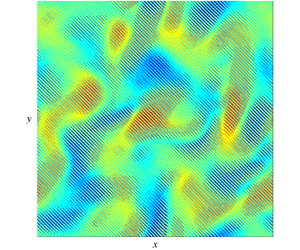Published online by Cambridge University Press: 06 November 2019

This study explores the control of mesoscale variability by topographic features with lateral scales that are less than the scale of the eddies generated by baroclinic instability. These dynamics are described using a combination of numerical simulations and an asymptotic multiscale model. The multiscale method makes it possible to express the system dynamics by a closed set of equations written entirely in terms of mesoscale variables, thereby providing a physical basis for the development of submesoscale parameterization schemes. The submesoscale topography is shown to influence such fundamental properties of mesoscale variability as the meridional eddy-induced transport and eddy kinetic energy. It is argued that the adverse influence of submesoscale topography on baroclinic instability is ultimately caused by the homogenization tendency of potential vorticity in the bottom density layer. The multiscale model formally assumes a substantial separation between the scales of interacting flow components. However, the comparison of asymptotic solutions with their submesoscale-resolving numerical counterparts indicates that the multiscale method is remarkably accurate even when scale separation is virtually non-existent.